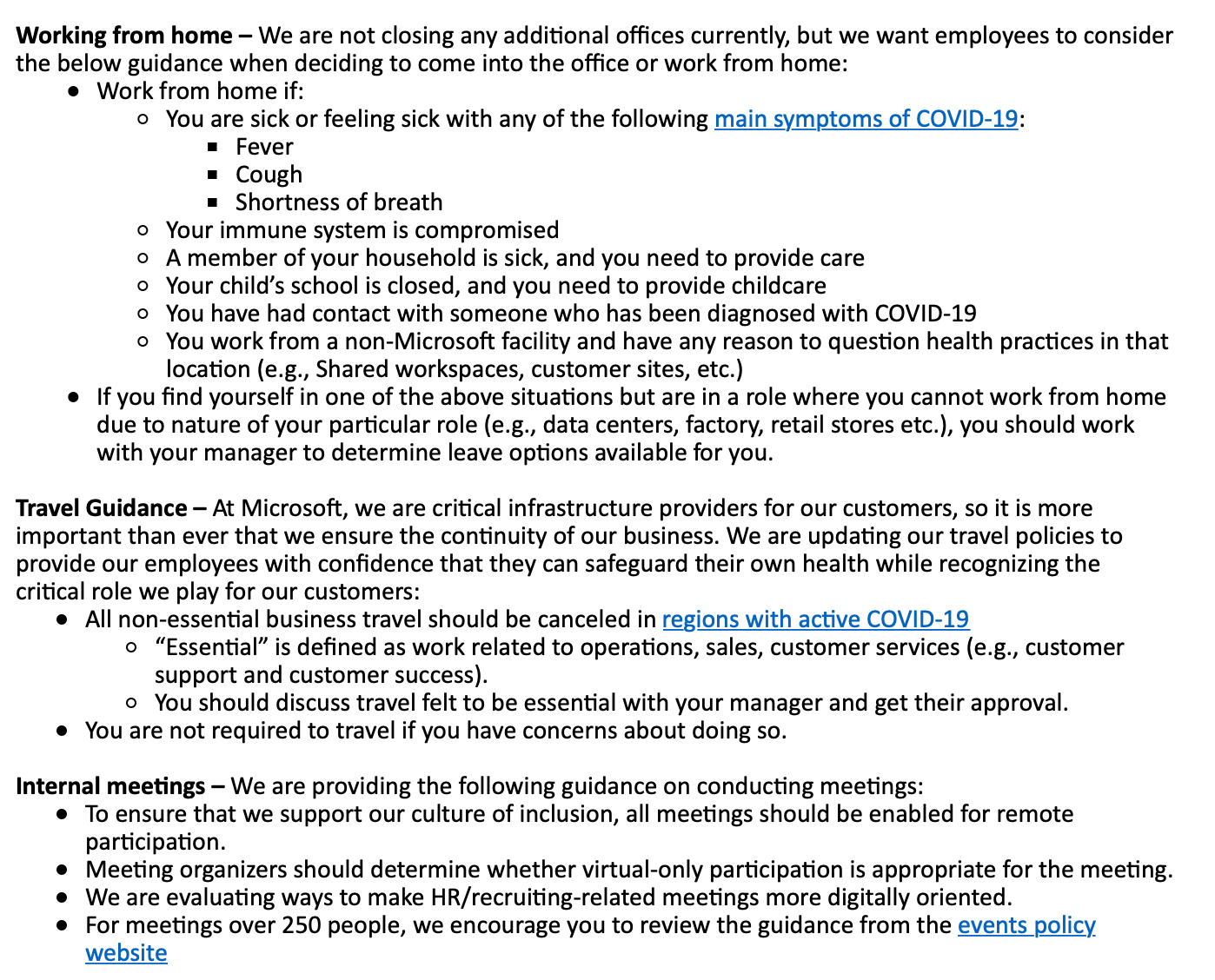Your coronavirus HR response plan: 10 things to know
The coronavirus (COVID-19) outbreak has everyone on edge. Its reach goes beyond the virus itself – Google, Facebook, Adobe, Microsoft, and others have either cancelled or pulled out of conferences, Italian soccer clubs have postponed matches, and even Japan’s upcoming Summer Olympic Games have come under scrutiny.

And now, Dr. Tedros Adhanom Ghebreyesus, director general of the World Health Organization, has called for governments worldwide to step up in combating the spread of the virus. “This is not a drill,” he said. “This is not a time for excuses. This is a time for pulling out all the stops.”
This call to action can and does trickle down to you in HR. The impact in the workplace is multifold. Office spaces are a hotbed for contamination – whether it’s due to sealed ventilation systems, open-office environments, employees going on work trips and coming into contact with others on a regular basis, and so on.
But guess what? Not everyone realizes this. “While 62.6% of office workers are concerned about COVID-19, it’s also interesting to see that only 41% feel their office will be a hotbed of infection,” says Gabrielle Ayala, principal of Propeller Insights.
However, it’s an inevitability: as the coronavirus crisis continues to grow, your colleagues in your organization – and even your CEO – will be turning to you for direction and support.
This is your time to step up and show that you’ve got this. You need to take leadership in HR and implement a quick coronavirus HR response. It’s also essential to your company’s overall health.
“Perhaps [office worker] awareness and sensitivity to this public health concern will drive proactive measures to keep the virus from entering their work environment,” Ayala continues. “More than 50% say they believe the COVID-19 outbreak will lead to more companies adopting a virtual office environment and are also in favor of using preventative measures [such as face masks], at the office.”
To help you with coronavirus HR response planning, we’ve pulled together the key takeaways on what you need to know and how you can act to build out your own response in your workplace.
1. Stay compliant
First of all, compliance is key. Sure, you’re fine if you address this as a company looking to take care of employees, but as Katie Clarey warns in HR Dive, businesses need to take careful steps to avoid the slippery slope to discrimination. It’s commonly understood that the virus originated in Wuhan, China, and that can lead to dangerous assumptions about people of Chinese origin – a clear rights violation.
Better to be safe in your communications and language, and address actions rather than people – for instance, you can say: if you’ve been to China in the last XX days, then we recommend working from home for a specified number of days as a precaution.
If you’re not sure what to implement, you can look at two federal laws that protect workers in the US: Title VII of the Civil Rights Act of 1964 and the Americans with Disabilities Act (ADA). The key is to not overreact as that could become a compliance issue.
2. Scale your response
Cathy Reisenwitz, head of content at Clockwise, a San Francisco-based calendar SaaS company, told us about three scenarios that their CEO Matt Martin presented during an all-hands meeting:
Level 1: Where we are now
- Wash hands
- Stay home if feeling “off”
- No international travel, etc.
Level 2: If the virus hits around 1,000 people in the area
- No more office visitors
- Cut down on travel to breakout areas
- Plan commutes to outside rush hour, etc.
Level 3: If the virus hits around 5,000 people in the area
- Mandatory work from home across company, etc.
Cryptocurrency trading website Coinbase has publicly released their communications outreach, including a clearly set-out plan for actions in response to specified triggers and benchmarks (at the bottom of the document). Its strategy is similar to that of Clockwise, plus restrictions on meal delivery and contingency plans for managers and teams.
It’s a good idea to outline all this in one place so everyone has the same information and they know what to expect in the short and long term. Having a scaled response plan in place also avoids having to bring out all the stops at once – which could induce unneeded panic in your workforce.
3. Adapt WFH and sick policies
The option to work from home is a common perk offered by businesses. This option can be an especially pertinent tool now. If you don’t yet have a WFH policy, you might want to build one out. Colleagues can also be reminded of the company’s sick-day policy – and especially, the option to work from home if you’re feeling OK to work but not quite well enough to come into the office.
Twitter and Square – among many others – are doing it already. A widely circulated memo from Microsoft has set down clear guidelines for working from home along with other essential information:

David Reischer, CEO of the legal advisory website Legaladvice.com in New York City, is encouraging some of his sales teams to start working from home as a precautionary measure, acknowledging the inevitable spread of COVID-19 in NYC’s large and very transient population.
“We would rather our workers start thinking about the idea of working from home now so that they can transition before the eventuality of the coronavirus arrives,” David told us.
“I think we will be ready when coronavirus becomes more widespread in NYC because of our early preparations.“
Andrew Discolli, HR editor of career service The Corporate Con/noisseur, emphasized loosening up existing WFH policy:
“I would recommend that all employers institute levels of flexibility across their workforce. This means allowing employees to work from home or utilize sick days as needed and in a manner that will maintain the health and level headedness of all staff.”
Simon Hansen, founder of a website dedicated to home brewing and winemaking called Homebrew Advice, adjusted the required hours put in by his colleagues:
“We now have lesser work hours in order to make sure that everyone gets the right amount of rest in order to recharge and strengthen our immune systems.”
Even country governments have stepped in to advise work from home. Authorities in Japan have advised companies to allow working from home to stem the spread of the virus, normally taboo in this notoriously work-conservative culture. Japan has already shut down their schools, followed by Italy, and WFH flexibility will be helpful to parents who have no other option but to stay home with their children.
Meanwhile, HR expert Suzanne Lucas advises taking a good look at your sick leave policy, because an overly regimented system can actually contribute to the outbreak rather than help contain it. She suggests opening up the allowed number of sick days, allowing for greater flexibility, and dumping the “doctor’s note” requirement.
4. Reduce or eliminate travel
A Reservations.com survey found that 43% of those surveyed would definitely cancel an international business trip, and 63% would “probably, very probably, or definitely would cancel” any business trip whether domestic or abroad.
Many employees travel – be it to sales pitches, meetings, other offices, conferences, what have you. Right now, with the emphasis on cutting back on travel, there’s likely to be understandable anxiety around business-trip planning within your workforce. Make it easy on your employees. Don’t put them in the difficult position of having to make that decision for themselves. Put in a clear policy with clear black-and-white decision-making protocols and stick to it.
The same can apply to personal travel either by the colleague in question or someone in their immediate family. The above survey finds that 66% say they’re not likely to cancel a vacation – which heightens the importance of clear policy.
Many companies are doing it. Take it to the next level by outlining clear scenarios, such as the following, to help your colleagues decide:
Scenario 1: I went to Lombardy for work on February 17.
Scenario 2: I’m planning a trip to China in mid-March. It’s for a sale that will be huge for our company.
Scenario 3: My spouse is coming back from a trip to Singapore.
Scenario 4: I booked a trip to visit my family in Tokyo in March. This was months in the planning.
A potential answer to any of these scenarios could be: “Contact your manager and be prepared to work from home for two full weeks on return. No entry to our offices or meeting with colleagues in person until after that.” You’ll also want to include information about absolutely necessary travel tips that apply regardless of whether the trip is for business or pleasure.
Andrew at the Corporate Con/noisseur has adjusted travel policy in his own company: “Unless approved by senior management, all non-essential travel to any location is currently on pause.”
And what if your company’s survival depends on travel? Lauren McAdams, HR manager and recruiter at ResumeCompanion attested to that:
“Our office has a number of employees who regularly travel to China and Taiwan for business trips. While most of these employees haven’t been abroad in the past 15 days, we still want to be as safe as possible. As a result, we’ve requested that anyone who’s recently flown abroad work from home for the following week while they self quarantine.”
5. Enable your employees
Many colleagues – and people in general – will be frustrated with their existing health support system wherever they are. For example, this recent Twitter stream from a physical therapist in Seattle who exhibits all the symptoms of COVID-19 – as of March 5, it was retweeted more than 120,000 times. As she tells it, she’s had to navigate the frustrating bureaucracy of the US healthcare system to not much avail.
You can enable your employees with clear and empathetic messaging on WFH and sick leave (as in #3 above) and allowing for greater flexibility in options and better enable them to seek out healthcare in a situation such as mentioned above. It will go a long way in showing your employees that you care about them.
6. Equip your employees
“The unknown is so much more frightening than the known,” says Canadian medical historian Heather MacDougall in the National Post on the heightened worldwide response to the crisis.
Nothing quells fears better than information. Educate your workforce on what they specifically can do to prevent the spread of COVID-19 to themselves or others, and you’ll assuage much of the potential panic. It helps to know that this is not an entirely uncontrollable situation.
For instance, encourage vigorous washing of hands. Buy hand sanitizer for every desk. Have a handful of thermometers at the ready (but being sure they’re not shared once used). Share updated information in regular memos via email, online chat channels, and notices posted in prominent locations online and around the office (e.g. the aforementioned Coinbase document).
Atilio Spaccarotella, CEO of travel insurance firm Rene Health in California, told us that at Rene, “we are following the WHO’s guidelines of practicing good respiratory hygiene, like sneezing or coughing into a flexed elbow [the ‘Dracula cough’] and washing your hands regularly with either alcohol-based hand rub or soap and water.”
7. Keep your office (even) cleaner
Adam Povlitz, president and CEO of commercial office cleaning service Anago Cleaning Systems offered some best practices on maintaining a clean office space, citing his company’s focus on healthy workspaces around the world – which will help you in your own office sanitation initiatives (as well as those of your employees):
- Read the label of your cleaning supplies so you know what’s in them.
- Check the websites – many cleaning supply companies are updating their sites with information specific to COVID-19.
- Know your cleaning supplies – hydrogen peroxide with a dilution ratio of 7% or more will kill the virus. Most household cleaners are 3%, so you’ll need commercial-grade materials.
- Disinfect and wait. All disinfectants take time to take effect, i.e. left on the surface for a period of time. Spraying and wiping will have no effect. And do not use bleach.
- Time parameters also apply to:
- Washing hands: 20 seconds or more using soap and water.
- Alcohol-based hand sanitizer: rub solution in for 30 seconds and even up to 2 minutes to be effective.
You’ll especially want to maintain high sanitation in a sealed office space or an open-office environment or, obviously, both. “Open office spaces are among the worst for COVID-19, particularly if they are sealed office spaces without open ventilation and the air is just recirculated within the building,” says E Hanh Le, M.D., senior director of medical affairs at Healthline.
People are understandably nervous about this – a Bospar survey finds that 50.6% of Americans are worried because they work in an open office.
8. Educate yourself
The aforementioned Bospar survey finds: “A majority of Americans (52%) say the media is overhyping the coronavirus and 60.9% believe the media can help ease fears about the coronavirus by educating members of the public about how they could fight the spread of the disease.”
Andrew at the Corporate Con/noisseur says as much:
“Day-to-day, there appears to be a level of confusion and fear throughout our offices. Our primary concern and focus is on the health and well-being of our employees.“
Since you’re in HR, many people in your company will be turning to you for advice and answers. What you can do to help them is brush up on your real knowledge of the virus, how it spreads, where it’s spreading to, and so on. That way you can sift through the online noise and know what’s real and what’s just hype.
Some pages to get you started:
- US Centers for Disease Control and Prevention on Coronavirus
- World Health Organization Q&A
- World Health Organization public advice
- World Health Organization Coronavirus homepage
9. Tech is your friend
Companies worldwide are understandably nervous about impact on the bottom line in a shutdown scenario. But technology can help you do business as usual – it can continue in a virtual environment.
Computer viruses notwithstanding, it’s impossible to contract sickness via the Internet – so meetings and presentations can still happen via video tools such as Google Hangouts or Microsoft Zoom. Communications can take place via online chat channels and email. Legally sensitive documents can be, at the very minimum, faxed (yes – fax is still a thing). There are also phones, of course.
Bospar’s survey finds that this is understood and expected: “51.4% believe viruses like COVID-19 and the flu will lead to companies adopting virtual offices.”
Michael Alexis, CEO of Teambuilding, talked about how his company launched a new wing of the business in less than 24 hours – enabling team building activities that can be facilitated virtually via online calls. “The expectation is more people will be working remotely, and still need ways to connect and bond,” he says.
Even your own work in recruitment can benefit from technology here. Numerous companies – including Amazon, Facebook, VSCO, Twitter and more – are utilizing video interview tools for candidate interviews.
10. Everyone calm it down
Finally, whatever the level of the situation, panic will not help matters. Staying calm is essential, and because you’re leading the information brigade in your coronavirus HR response, it’s up to you to ensure that everyone feels relatively confident and informed – and safe.
Andrew of The Corporate Con/noisseur, says: “We are looking to remain calm and ensure that our employees have access to the supplies and information they need. Keeping calm and understanding the guidelines of the CDC are our best bet.”
Many notable companies are even going fully transparent with their internal communications and policies in response to the virus. If you want to see what they’ve got, more than 100 company policies have been collected in this crowdsourced Google doc.
People are scared and unsure of what’s going on. This is your chance to help quell those worries with clear policy and clear directives, step by step, with full transparency and uniform messaging and implementation. Your employees – and management – will be grateful.




